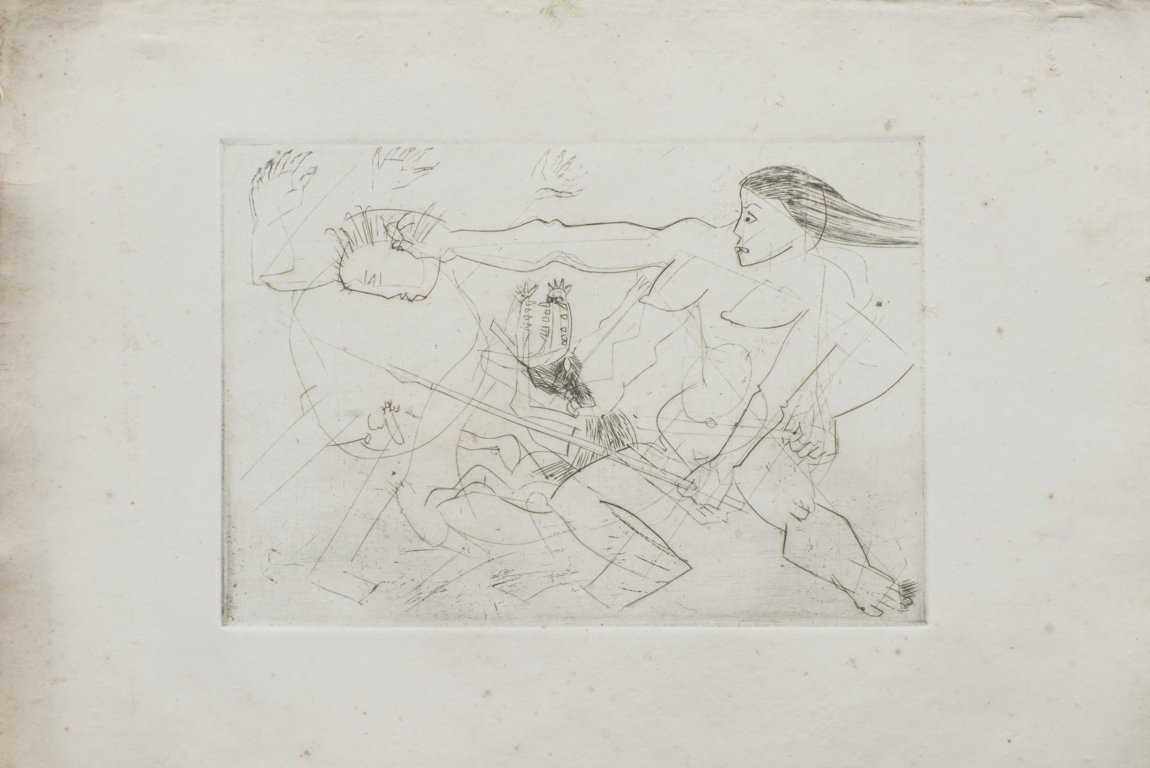
100 Years of Somnath Hore
Asia Week New York - Autumn 2022
August 26th – October 15th, 2022 at Akar Prakar, Kolkata
A printmaker, painter and sculptor, Somnath Hore’s works are a reflection of his sensitivity and empathy towards his subjects. Beginning his practice during some of the hardest social and political time in the country like the Bengal famine and the pre-independence struggle, Hore’s sketches were the visual representation of his first-hand experience. In his life, his association with the Communist Party and his personal political beliefs deeply influenced his imagery.
Experimenting with forms and techniques, especially in his printmaking, he was able to invent his own technique known as the white on white pulp prints and popularly referred to as the ‘Wounds’ series. In his practice, the swift strokes of his ink & brushwork, the minimalist representations of his woodcuts, the hollow core of his bronze sculptures or the striking textures of the wounds series became the signature styles of his artistic language.
Though for Somnath, his ideologies and beliefs never came in the way of his artmaking. When the limitations placed by the Communist Party became too restrictive, he resigned from his post in the party and moved to Delhi in the 1960s to teach printmaking at the Delhi Polytechnic. During those years, his practice became widely recognized in the art world and he received several awards like the Lalit Kala Akademi Award his works were a part of international exhibitions like the Venice Biennale, and the Sao Paolo Biennale.
Eventually, when the disconnected nature of the art world in Delhi became too stifling he resigned from his post and moved to Santiniketan. For Hore, it was this change that helped him re-establish his love for the arts. He was awarded the Emeritus professorship at Kala Bhavan, Santiniketan in 1983. The isolation and the artistically fertile atmosphere of the city became the reason behind Somnath making it his home till the very end. Dedicating more than six decades of his life to his art, Hore passed away in the year 2006. His art, transcending the times still resonates with the audience and cemented his place as one of the master artists of Indian Art.
Somnath Hore | Untitled (8-9) | Lithograph | 11.5 x 14 in | 1969
Somnath Hore | Untitled | Etching | 4.5 x 3.5 in
Somnath Hore | Untitled | Etching | 5 x 6.75 in
Somnath Hore | Untitled | Etching | 5.75 x 7 in
Somnath Hore | Untitled | Etching | 5.25 x 7.25 in
Somnath Hore | Untitled | Etching | 5.75 x 7.25 in
Somnath Hore | Untitled | Etching | 6.25 x 3.5 in
Somnath Hore | Untitled | Etching | 8 x 9.25 in | 1978
Somnath Hore | Untitled | Lithograph | 5.25 x 4.25 in
Somnath Hore | Untitled | Woodcut | 7 x 4.75 in
Somnath Hore | Untitled | Linocut | 4.25 x 6.25 in
Somnath Hore | Wounds 27(Artist Proof) | Pulp print | 19.5 x 24 in | 1973
Somnath Hore | Untitled (Artist's proof) | Etchings on handmade paper | 11 x 15 in | Circa 1970
Somnath Hore | Untitled (Trial Proof) | Lithograph | 11.5 x 15.25 in | 1969
Somnath Hore | Untitled | Mixed media | 6 x 7.5 in | 1980
Somnath Hore | Untitled | Pen & ink on paper | 7 x 10.75 in | 1972
Somnath Hore | Untitled | Pen & ink on paper | 7 x 10.75 in | 1972
Somnath Hore | Untitled | Trial proof | Woodcut | 6.75 x 8 in | 1973
Sonmath Hore | Untitled | Pulp pulp | 8.5 x 8.75 in
Somnath Hore | Untitled | Bamboo Brush Paint on Paper | 19.25 x 26.5 in | 1977
Somnath Hore | Untitled | ink & brush | 7.75 x 4.75 in | 1975
Somnath Hore
Somnath Hore was born in 1921, in Chittagong (now in Bangladesh). He received a diploma in printmaking from the Government College of Art and Craft in Calcutta, while being closely associated with the Communist Party. He went on to carry out visual documentation and reportage of the Bengal famine in 1943 for the Communist Party magazine Jannayuddha (People's War). Socialist ideologies formed around the Tebhaga movement in 1946 in Bengal influenced the early phases of his artistic career. By the 1950s he was regarded as one of the premier printmakers in India and headed the Graphics and Printmaking Department at Kala Bhavana in Santiniketan, after returning from Delhi where he was in charge of the Printmaking Department of the Delhi Polytechnic in 1958.
He showcased his works in numerous national and international exhibitions including the Venice Biennale, Italy in 1962 and the Sao Paolo Biennale, Brazil in 1963 to name a few. The 'wound series' that he started making in the 1970s, was a unique technique of prints on paper pulp. By the mid-1970s, he turned to wax modelling, subsequently which was transferred to bronze. He was awarded the Lalit Kala Ratna Puraskar by Lalit Kala Akademi, New Delhi in 2004. The National Award (Painting) by Lalit Kala Akademi in 1960, and the National Award (Graphics) by Lalit Kala Akademi in 1963. He was honoured as Professor Emeritus at Kala Bhavana, Santiniketan in 1984. In the same year, he was awarded the Gagan-Aban award in Kolkata. Somnath Hore passed away in 2006 at the age of 85 in Santiniketan.
























